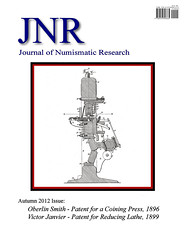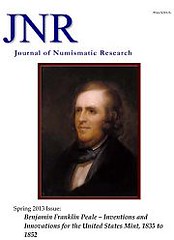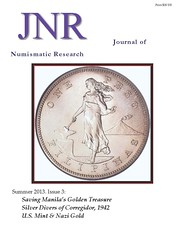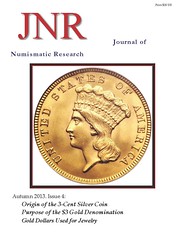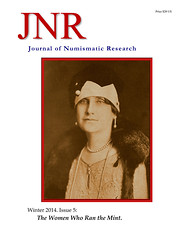
PREV ARTICLE
NEXT ARTICLE
FULL ISSUE
PREV FULL ISSUE
THE JOURNAL OF NUMISMATIC RESEARCH
Roger Burdette publishes the Journal of Numismatic Research. Since 2012 this occasional publication has addressed a wide range of fascinating numismatic topics at length and in detail not always suitable for other periodicals. At my request Roger kindly forwarded a summary of the issues published to date.
-Editor
Journal of Numismatic Research (JNR) – Autumn 2012, Issue #1.
Price $10 retail.. “VICTOR JANVIER – PATENT FOR A MODEL REDUCING MACHINE, 1899.” (TRANSLATION BY MARGAUX C. THIEME-BURDETTE) Among American numismatists Victor Janvier is known almost entirely for the model reducing machine of his invention that was installed in the Philadelphia Mint in 1906. The French patent, number 294123, was issued on November 8, 1899 and amended in February 24, 1902. This is the first publication of his patent and includes all documents remaining in the French patent office archive. Journal of Numismatic Research (JNR) – Spring 2013, Issue #2.
“IMPROVEMENTS IN THE METHOD OF MAKING WORKING DIES AND REDUCTIONS – 1835.” One of the goals of mint officials was uniformity of the coinage. Every piece of a certain denomination should be identical in weight, purity, size, shape and design to every other of the same denomination. To accomplish this, the mint went to considerable trouble to verify the all the blanks and planchets for coining were uniform. But when it came to actually making dies and striking coins from them, a multitude of factors intruded. “IMPROVEMENTS IN ASSAYING AND PARTING SILVER, AND RECOVERING PRECIOUS METALS FROM WASTE WATER – 1835.” The two primary reasons for sending Franklin Peale to Europe in 1833 were to learn how to perform the “humid assay” of silver, and how to perform large scale parting of gold and silver using sulfuric acid. As with most tasks, Peale overcame reluctance by some of his European hosts and succeeded admirably in his assignment. “INVENTION OF A TOGGLE-JOINT COINAGE PRESS – 1835.” The steam powered coining press designed by Franklin Peale is simultaneously his most recognized invention and the least well understood by coin collectors. This is understandable when one realizes that popular descriptions emphasized the use of steam power, rather than the singular technology of the press. “IMPROVEMENTS IN ROLLING, DRAWING AND ANNEALING – 1835-1839.” Among lesser known mechanical improvements made by Franklin Peale were changes in the rolling mills, drawbenches and annealing furnaces. At present we have none of Peale’s drawings relating to these improvements and only incomplete descriptions of his work. “INVENTION OF THE ECCENTRIC DRIVE BLANK CUTTING PRESS – 1836.” new presses were fast and required large quantities of blanks and planchets. To solve the problem of cutting blanks, Peale designed two somewhat different blank cutting presses for the U.S. Mints. A small version was introduced in 1836, and a second much larger type was designed and built between 1837 and 1851. Both designs dispensed with the obsolete screw press mechanism. “INVENTION OF THE UPSETTING MACHINE – 1836.” While Franklin Peale was melter and refiner he invented and introduced the upsetting (or milling) machine, moved by steam power, for placing the raised edge on the rim of the coin. This machine was substituted for the imperfect and inefficient band machine, the only one previously known in the Mint. Such was the efficiency of the machine introduced by Peale that eight hundred (800) of the smaller denominations of coin per minute do not by any means limit its capacity. “IMPROVEMENTS OF THE PILING BOX AND COIN COUNTING BOARD – 1837 AND 1839.” Counting boards and piling boxes might appear to be trivial innovations. Making piles of coins or blanks was a simple matter and counting was basic to most mint operations. Counting coins has been an important requirement of money-based economies since the first use of coinage. Stacking or piling coins is a more recent, though still very old practice. As a growing economy demanded larger quantities of coins, simple piece-by-piece counting failed. “DESIGN FOR A STEAM ENGINE – 1839.” Peale’s 1839 horizontal steam engine was not the first used by the Philadelphia Mint, but it was the first to be fully designed and built with specific needs of the mint in mind. Power production was modest – just twenty-five horsepower – but the machine was quiet, reliable, and simple to operate by standards of the time. “IMPROVEMENT OF BALANCES – 1835-1847.” Accurate analytical and bulk weighing balances were critical to the quality of American coinage. But when Peale visited the Paris Mint in 1833 he realized that the U.S. Mint was laboring with poor quality equipment. He acted quickly to relieve the situation and continued improving weighing equipment for the next fifteen years. “IMPROVEMENTS IN ELECTROTYPING FROM MODELS OF METAL, WAX AND PLASTER – 1840.” The miracle of electricity was a primary subject of scientists and philosophical experimenters in the early nineteenth century. Working mostly as individuals, and collaborating through numerous letters and publications, electrical researchers rapidly gained a basic understanding of what electricity could do. Franklin Peale worked with a very simple electrotyping apparatus known as single cell deposition. This method did not require constructing a battery, but depended only on the small current developed within a container, to deposit copper onto a mold. “HIRING OF WOMEN TO ADJUST PLANCHETS AND OPERATE PRESSES – 1850.” Men were employed to adjust planchets and operate presses until early 1850 when women were given a trial as adjusters by coiner Franklin Peale. His innovation was to turn a significant part of the coining process over entirely to female employees, and to do this within a major government bureau. His decision was evidently inspired by a combination of errors by the male adjusters, and the drive to save money. “DESIGN FOR A STEEPLE ENGINE – 1851.” The last major design project by Franklin Peale was for a new vertical steam engine for the Philadelphia Mint. By this time the science of machinery had left the designer in the dust and his best effort was functionally obsolete before it was completed. “OPINIONS AND COMMENTS ON COINAGE AND MINT OPERATIONS 1855, 1870.” Peale’s opinions about American coinage were remarkably consistent during his lifetime. Some found their way into the Coinage Act of 1873, others fell by the wayside, and still others have yet to be considered. This brief article presents his opinions and suggestions for present and future numismatists to contemplate. Price $20 retail. Journal of Numismatic Research (JNR) – Summer 2013, Issue #3.
“SILVER DIVERS OF CORREGIDOR, WORLD WAR II: MAY TO NOVEMBER 1942.” Just before the Philippine island of Corregidor fell to the Japanese, large quantities of silver coins were dumped in in Manila Bay. It was hoped that the coins could thus be hidden from the invaders. Within days, the silver coins were located and American prisoners conscripted to bring the valuables to the surface. “U.S. MINT & NAZI GOLD, MERKERS KAISERODA SALT MINE TREASURE, WORLD WAR II: JUNE TO AUGUST 1945.” Under orders from Nazi leadership, primarily Hermann Goering and Heinrich Himmler, conquered people and nations were systematically stripped of art, gold and other valuables. Recovery of the treasure after the end of the European war had an unexpected connection to the U.S. Mint. Issue price $20 retail. Journal of Numismatic Research (JNR) – Autumn 2013, Issue #4.
“JAMES B. LONGACRE AS A DIE ENGRAVER” A reassessment of the artistic and engraving talent of the Engraver fo the United States Mint. “PURPOSE OF THE $3 GOLD COIN” Coin collectors have long wondered why Congress approved introduction of a $3.00 gold coin in 1854. Numerous speculations have been put forward, but none identified the initial motivation for this odd, seemingly useless denomination. “GOLD DOLLARS USED FOR JEWELRY” Necklaces, bracelets, cufflinks, rings, pendants and a multitude of other items of personal adornment became the final resting places of thousands of tiny gold dollars. Coin collectors were the only refuge for these forgotten gold pieces. Issue Price $20 retail. Journal of Numismatic Research (JNR) – Winter 2014, Issue #5.
“MARGARET ELLEN KELLY – Acting Director of the Mint” “MARY MARGARET O’REILLY – Assistant Director of the Mint” “NELLIE TAYLOE ROSS – Director of the Mint” Issue Price $20, retail.
If you don't already have these in your numismatic library, consider ordering today. This is a Herculean effort that deserves the support of the hobby.
-Editor
For more information, or to order, see Wizard Coin Supply:
To read the earlier E-Sylum articles, see:
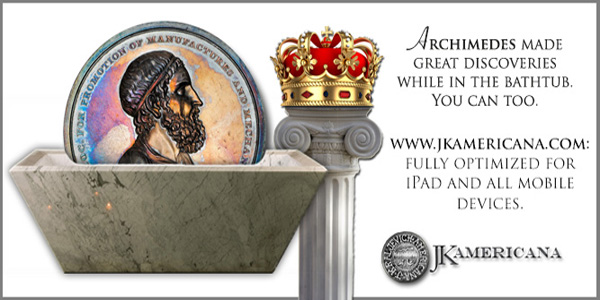
Wayne Homren, Editor The Numismatic Bibliomania Society is a non-profit organization promoting numismatic literature. See our web site at coinbooks.org. To submit items for publication in The E-Sylum, write to the Editor at this address: whomren@gmail.com To subscribe go to: https://my.binhost.com/lists/listinfo/esylum All Rights Reserved. NBS Home Page Contact the NBS webmaster 
|
